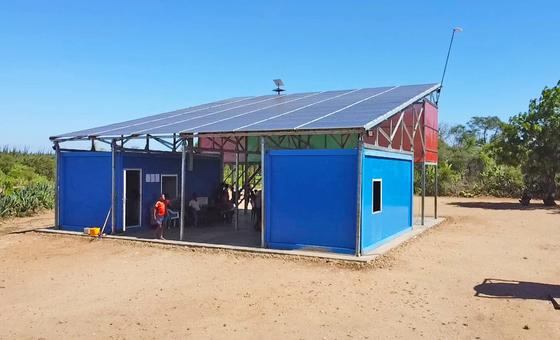
Droughts, partly caused by climate change and the resulting lack of water, have driven many communities to the brink as they have been unable to grow the crops they rely on for survival. Many are forced to rely on humanitarian aid.
But now, the availability of electricity and water is reviving many villages, including Fenoaivo in the Anosy region, according to the WFP’s Avimaro Mikendremana.
“The people of Fenoaivo have suffered greatly. In 2020, they experienced famine-like conditions after successive rains failed, and they were unable to grow enough food to eat. The effects of the drought were very severe, and the village needed to be supported with humanitarian relief aid.
When we asked what they needed most, the answer was always water and then electricity. People told me that this combination would save them from experiencing near famine again and having to rely on others to bring in humanitarian aid.

WFP’s Avimaro Mikendremana.
It’s clear that water and electricity are the essential building blocks of development, so we wanted to pilot a programme which would look at what impact that combination would have on some of the poorest villages in the south of Madagascar.
In Fenoaivo, a village of about 300 households, we worked with the government and started by sinking a water hole some 35 metres beneath the surface and then built a storage tank of 20 cubic metres. This water needs to be brought to the surface, which requires a pump. The electricity to work that pump is provided by the 72 solar panels which we built on a structure that was erected in the middle of the village.

The availability of electricity, as part of the Rapid Rural Transformation initiative, is leading to more entrepreneurial opportunities like barber shops.
Now available: Buzz cuts
There is abundant sun, and the panels generate around 25 kilowatts of clean and renewable electricity, which is enough to power a whole range of new activities and open up opportunities that the village has never had before.
The water, which is clean and drinkable, is used to irrigate crops, including in a greenhouse where melons are growing at the moment.
A digital learning centre has been created with internet access so people can study remotely and, for the first time, there are lights in the village, which provide more security at night, especially for women.
Now, the church has electricity, and the school will follow. Small entrepreneurial activities have been established, including a restaurant and a barber shop. Men are excited to get their first ever buzz cuts as now the barber has electricity to power his clippers.
The businesses pay a small amount of money in rent and for the electricity, which is collected by the community association elected to run the project. Some of that money will be used to buy bricks to build three school classrooms.

Watermelons are being grown in a greenhouse in the village.
Change of attitude
This is a traditional rural community where farming has typically been the only income-generating activity, so this intervention, which is called Rapid Rural Transformation, will require people to recognize and embrace the opportunities.
The project started in January 2023, and already people are seeing that water means more food, better nutrition and less sickness. It is also helping to build the resilience of the community, so they are ready to face future climate shocks.
I am excited for the community and passionate about this work, as I can see that this is how they can make the transition from being aid dependent to being self-sufficient and independent by making the decision by themselves about how to develop their village and their future.
Small steps are being taken right now, and WFP is still providing nutritional support for the treatment of moderate malnutrition as part of the emergency response to drought. However, if this initiative is a success, then WFP will seek to scale it up to bring water and electricity to many more vulnerable villages in the south.”

SDG 7
SDG 7: CLEAN ENERGY FOR ALL
- Increase share of renewable energy globally
- Double global rate of improvement in energy efficiency
- Expand infrastructure and upgrade technology for supplying modern, sustainable energy services
- Enhance international cooperation to facilitate access to clean energy research and technology, including renewable energy, energy efficiency and advanced and cleaner fossil-fuel technology
- Expand infrastructure and upgrade technology for supplying modern and sustainable energy services for all in developing nations, in particular least developed countries, small island developing States and land-locked developing countries
International funding for clean energy in developing countries has dropped to just $10.8 billion in 2021 from a peak of $26.4 billion in 2017.
